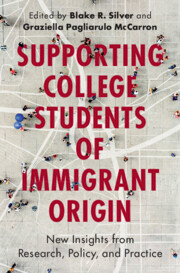Book contents
- Supporting College Students of Immigrant Origin
- Supporting College Students of Immigrant Origin
- Copyright page
- Dedication
- Contents
- Figures
- Tables
- Contributors
- Foreword
- Part I Beginnings
- Part II Experiences
- Chapter 6 Funds of Knowledge as Strategic Food and Campus Navigation at Selective, Affluent Universities
- Chapter 7 Psychosocial Stressors and Coping Strategies in Racially and Ethnically Diverse Undocumented College Students
- Chapter 8 How Colleges Can Support Working Students of Immigrant Origin
- Chapter 9 First-generation College Student Women of Immigrant Origin and Perspectives on the Role of Gender in their Experiences On- and Off-campus
- Chapter 10 Second-generation Afghan Immigrants Navigating Racial and Ethnic Identities in College
- Chapter 11 The COVID-19 Pandemic and Undocumented Hispanic/Latino/x College Men
- Part III Institutional Arrangements
- Part IV Looking Forward
- Epilogue
- Index
- References
Chapter 8 - How Colleges Can Support Working Students of Immigrant Origin
from Part II - Experiences
Published online by Cambridge University Press: 16 May 2024
- Supporting College Students of Immigrant Origin
- Supporting College Students of Immigrant Origin
- Copyright page
- Dedication
- Contents
- Figures
- Tables
- Contributors
- Foreword
- Part I Beginnings
- Part II Experiences
- Chapter 6 Funds of Knowledge as Strategic Food and Campus Navigation at Selective, Affluent Universities
- Chapter 7 Psychosocial Stressors and Coping Strategies in Racially and Ethnically Diverse Undocumented College Students
- Chapter 8 How Colleges Can Support Working Students of Immigrant Origin
- Chapter 9 First-generation College Student Women of Immigrant Origin and Perspectives on the Role of Gender in their Experiences On- and Off-campus
- Chapter 10 Second-generation Afghan Immigrants Navigating Racial and Ethnic Identities in College
- Chapter 11 The COVID-19 Pandemic and Undocumented Hispanic/Latino/x College Men
- Part III Institutional Arrangements
- Part IV Looking Forward
- Epilogue
- Index
- References
Summary
This chapter aims to provide recommendations for how colleges can best support working college students of immigrant origin. It examines which challenges these students encounter when juggling full-time studies with working 20 or more hours a week during the academic year. Drawing on findings from qualitative, semi-structured interviews with twenty-four undergraduate students of immigrant origin in the northeastern United States, we show that these students face a confluence of challenges. The participants experienced academic, emotional, and social difficulties resulting from a time deficit and found the unpredictability of work hours and schedules challenging. They reported stress, anxiety, emotional depletion, sleep deprivation, exhaustion, and a lack of faculty support. We offer program and policy suggestions for higher education administrations and faculty to stem this confluence of challenges. These include gathering institutional data about the labor force engagement of their student population, vetting jobs on and near campus for their “student friendliness” (set time schedules and predictable, limited hours), and educating students about which jobs are student-friendly.
Keywords
- Type
- Chapter
- Information
- Supporting College Students of Immigrant OriginNew Insights from Research, Policy, and Practice, pp. 155 - 175Publisher: Cambridge University PressPrint publication year: 2024

